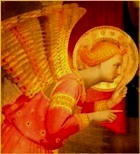Did Jesus marry Mary Magdalene?
Magdalene and Jesus married? Lovers?
Questions for Bible study groups
- What sort of woman was the real Mary Magdalene?
- What were contemporary criticisms of Jesus?
- Was Mary Magdalene an ex-prostitute?
- What would have been the reaction to Jesus’ wife, if he had been married?
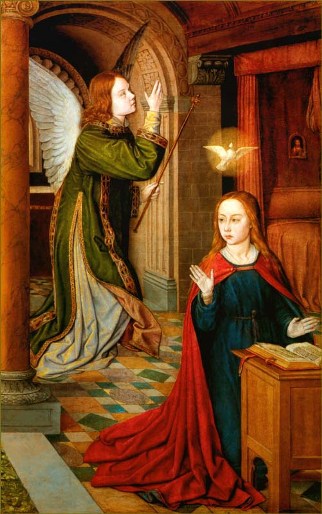
Were Jesus and Mary Magdalene married? Lovers? In a word, No.
We know this mainly because Jesus’ enemies never accused him of sexual misbehavior, which they certainly would have done if there was any likelihood of it being believed.
In the years after his death, Jesus was attacked on two points:
-
- his apparent illegitimacy; this was a serious charge, more so then than now, since a religious teacher had to have an impeccable family background and have parents who were esteemed in their community
- his fondness for eating and drinking, especially with the wrong kind of people.
- To counter the first accusation, two of the gospels (Luke and Matthew) go to a lot of trouble explaining the unusual circumstances of Jesus’ conception and birth.
- To counter the second accusation, all of the gospels emphasize Jesus’ enjoyment of people and social gatherings, but are careful to place them within the context of his outreach ministry to people, especially the disadvantaged.
The enemies of the first Christians would certainly have accused Jesus of sexual misbehavior if there had been the slightest chance this charge would stick. No-one ever seems to have made the charge.
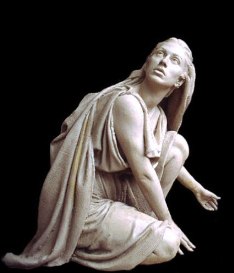 Another point: at the moment of extreme emotion when Mary sees Jesus for the first time after the Resurrection, she calls him ‘rabbouni’, the title his disciples used. She did not call him by his personal name of ‘Jesus’, which she surely would have done if she and Jesus had had the sort of intimate relationship that has been suggested in popular novels.
Another point: at the moment of extreme emotion when Mary sees Jesus for the first time after the Resurrection, she calls him ‘rabbouni’, the title his disciples used. She did not call him by his personal name of ‘Jesus’, which she surely would have done if she and Jesus had had the sort of intimate relationship that has been suggested in popular novels.
In complete shock at the sight of a living man whose dead body she had seen only hours before, she used the word she had always used, ‘rabbouni’, teacher.
Who was the real Mary Magdalene?
She was not the gorgeous red-haired woman often shown in paintings of the crucifixion. Reality was much less romantic. Nor was she a repentant prostitute.
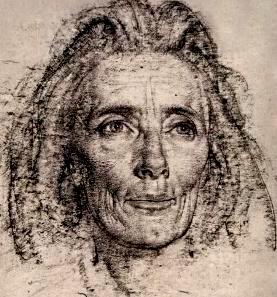 She was a middle-class Jewish business-woman from the town of Magdala, a town noted for its dried fish and wool dyes.
She was a middle-class Jewish business-woman from the town of Magdala, a town noted for its dried fish and wool dyes.- She had suffered a severe illness, which Jesus cured.
- She seems to have been financially independent, and able to offer financial backing for the itinerant rabbi called Jesus of Nazareth, and his group of disciples.
- She seems to have been the leader of the group of women who sometimes traveled with, or met up with, this group headed by Jesus. Men’s and women’s groups often traveled together, for example on the annual pilgrimage to Jerusalem, but they kept strictly within their own group. This is why Mary and Joseph, the parents of Jesus, did not realize for some time that the boy Jesus was missing, when he stayed behind in Jerusalem: each separate group thought he was with the other.
Was Mary an ex-prostitute?
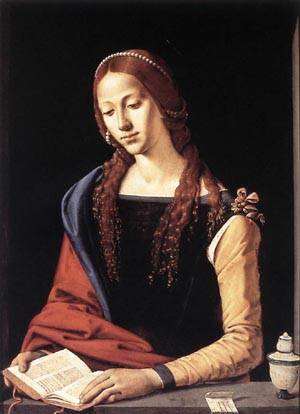 In quite a few paintings, Mary is confused with the woman with the alabaster jar, described in Luke 7:36-50 – see one of these paintings at right. The story of this other woman comes just before Mary Magdalene is first mentioned. The woman with the alabaster jar has the characteristic features that were later transferred onto Mary Magdalene: long flowing hair, tears of repentance, and a ‘past’. She is described in Luke 7:37 as a ‘sinner’, a word which was interpreted by the early Church fathers as ‘prostitute’. But in fact, when Luke describes an actual prostitute in 15:30, he uses a different word altogether.
In quite a few paintings, Mary is confused with the woman with the alabaster jar, described in Luke 7:36-50 – see one of these paintings at right. The story of this other woman comes just before Mary Magdalene is first mentioned. The woman with the alabaster jar has the characteristic features that were later transferred onto Mary Magdalene: long flowing hair, tears of repentance, and a ‘past’. She is described in Luke 7:37 as a ‘sinner’, a word which was interpreted by the early Church fathers as ‘prostitute’. But in fact, when Luke describes an actual prostitute in 15:30, he uses a different word altogether.- Later celibate male interpreters of the gospels linked Mary’s illness, her ‘demons’ (Luke 8:2) with her sexuality.
- Mary is also confused with the woman who has committed adultery, in John 8:1-11. Someone recently argued that people at the time of Jesus knew that Mary Magdalene was his wife because they threw stones at her. It is hard to know how to counter this sort of argument, since the person making the statement has obviously never actually read the gospels. The unnamed adulterous woman lived in Jerusalem in Judea, not Magdala in Galilee, where Mary came from. There would be no reason at all for anyone to stone a wife of Jesus, supposing he had been married. And the woman in the story is about to be stoned to death because she has been discovered in the act of adultery, not because she has married a popular rabbi.
- Showing Mary Magdalene as a beautiful ex-prostitute created a dramatic contrast to the Virgin Mary, the perfect virgin/mother. This contrast mirrored a philosophical idea popular during the period of the early Church: Platonic dualism. Plato had proposed that everything in the universe had an equal and opposite other, for example man/woman, logic/emotion, good/evil, light/darkness, etc, (see the introductory section on Mary Magdalene, link at top of this page). People of the time admired Greek thought and culture, so they emulated this way of thinking to shape their view of the world.
In the centuries following Jesus’ death, Mary Magdalene became everything the Virgin Mary was not: a reformed, flamboyantly beautiful whore who was the perfect foil for the modest virgin/mother Mary. Both images departed from the original, more mundane truth.
What did the people around Jesus think?
Jesus had a considerable following during his life, enough to make him a cause for concern to the Roman and Jewish authorities. The gospels often mention crowds of people who gathered to hear him teach. He was a noted rabbi and teacher during his life.
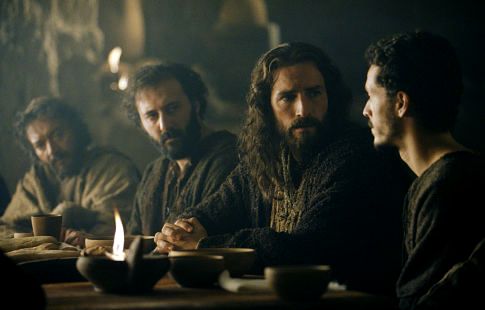 But Jews expect a high standard of behavior at all times from their rabbis, who must be constant role models to their followers. The Jewish crowds would never have paid any attention to a rabbi who consorted with a woman who was not his wife, or who had a ‘secret’ marriage. This would have instantly destroyed his credibility as a teacher.
But Jews expect a high standard of behavior at all times from their rabbis, who must be constant role models to their followers. The Jewish crowds would never have paid any attention to a rabbi who consorted with a woman who was not his wife, or who had a ‘secret’ marriage. This would have instantly destroyed his credibility as a teacher.
If his disciples had doubted his integrity for even a moment, as they surely would have if he had been having any sort of illicit relationship with Mary Magdalene, they would have abandoned him and turned to some other teacher. There were many rabbis and teachers in 1st century Palestine for them to choose from.
If Jesus was married, would they hide it?
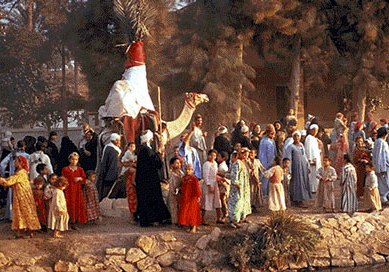 No, quite the reverse. At the time that Jesus lived, it would have been seen as a plus. Jesus was Jewish. The first commandment in the Jewish Scriptures is to ‘be fruitful and multiply’. Jews take this commandment so seriously that they have always endorsed marriage and sexual love.
No, quite the reverse. At the time that Jesus lived, it would have been seen as a plus. Jesus was Jewish. The first commandment in the Jewish Scriptures is to ‘be fruitful and multiply’. Jews take this commandment so seriously that they have always endorsed marriage and sexual love.
A Jewish man did not consider he had properly fulfilled his obligations to God until he was married; the only exception to this was a man who chose to devote himself to the study of the Scriptures, although even then he was encouraged to marry. It is not impossible that Jesus had been married as a young man and was a widower. It is more likely that he had chosen the second way of life, of teaching and studying Scripture, and had not married because his itinerant way of life made this impossible, in that culture at that time.
If Jesus had had a wife at the time of his ministry, he would have been proud of the fact. He would certainly not have tried to keep it hidden. There would have been no ‘secret marriage’. Christianity in a later period endorsed celibacy as a way of life, but as a Jew, Jesus would have been perplexed by the idea of celibacy, seeing it as non-fulfillment of God’s commandment to ‘Go forth and multiply’.
What was the gospel of Mary Magdalene?
This text was written at least a century after the events, and certainly not by Mary Magdalene. It was written for a specific purpose, to promote the role of women in the church hierarchy of the time, by people who believed in the truth of their own dreams/ visions.
Different translations of this ‘gospel’ give different impressions of the vision described. The exact meaning of the words is much debated. The original remnant of manuscript is badly worn, tattered and difficult to decipher. Moreover, the words are open to different interpretations, eg does ‘kiss’ mean the common kiss of greeting, or a sign of unity and compassion, or a sexually passionate act? The manuscript does not make this clear, and describes what seems to be a symbol-laden dream/ vision, not a real act.




